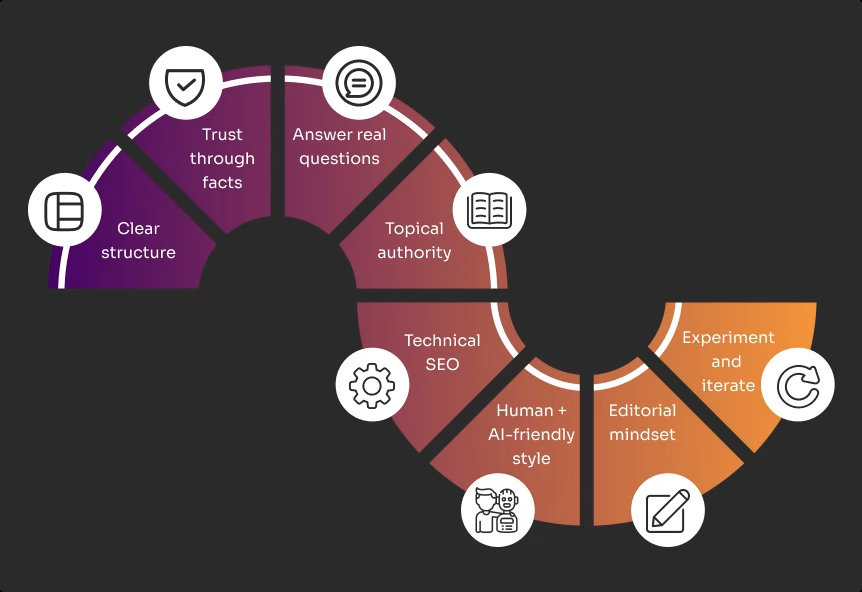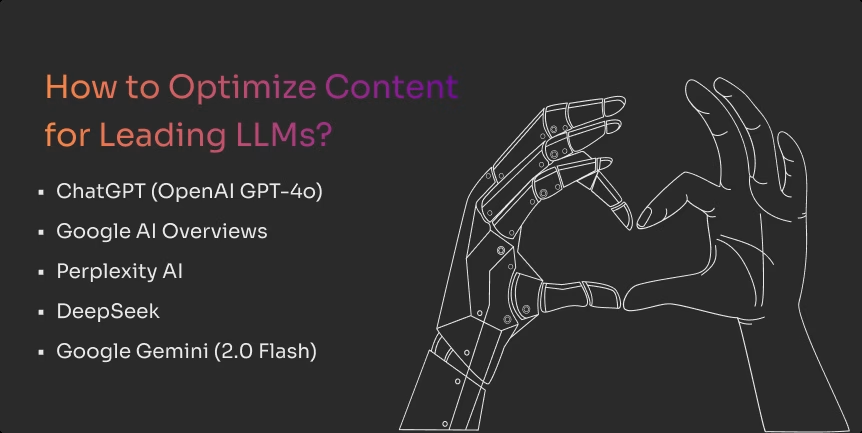
In the article, Why GEO Matters: The New Rules of Search Visibility, we explored how Generative Engine Optimization (GEO) is changing the way search works. With AI tools like ChatGPT, Perplexity, and Google SGE now delivering direct answers, search isn’t just about ranking anymore. It’s about being the source behind the answer.
We looked at how user behavior is shifting, what’s driving the rise of zero-click searches, and why traditional SEO on its own isn’t enough to stay visible. The bottom line: content needs to be created not just for people, but for the AI systems summarizing it.
Now it’s time to take the next step. In this follow-up, we’ll walk through how to adapt your content so it’s clear, credible, and AI-friendly. You’ll learn how to get your brand cited in generative results, how to structure content that AI can understand, and how to blend GEO and SEO into one smart, future-ready strategy.
Whether you’re refreshing existing pages or starting from scratch, the tactics in this guide will help you stay discoverable in a search landscape where visibility depends on more than just being on page one. It’s about being useful, verifiable, and ready for the way people search now.
Table of Contents
Key Benefits of GEO

As search evolves, so do the strategies needed to stay visible. Generative Engine Optimization (GEO) is designed for a world where AI answers user questions directly, often without a single click. Instead of chasing rankings alone, GEO focuses on making your content useful, clear, and discoverable by AI tools like ChatGPT and Google’s SGE.
1. Contextual Relevance That Improves Content and Keyword Targeting
GEO emphasizes the importance of context over exact-match keywords. By focusing on semantic relevance and user intent, content becomes more aligned with how AI models interpret and present information. This approach ensures that content is more likely to be featured in AI-generated summaries, increasing its reach and effectiveness.
2. Better Engagement and a More Satisfying User Experience
As AI-driven search tools provide direct answers, users receive information more efficiently. This immediacy enhances user satisfaction and engagement, as they no longer need to sift through multiple links to find relevant information. By optimizing content for GEO, businesses can meet users’ needs more effectively, fostering trust and loyalty.
3. Increased Visibility and Higher Rankings in AI Search Results
Optimizing for GEO can lead to higher visibility in AI-generated responses. Studies have shown that GEO strategies can boost visibility by up to 40% in generative engine responses, highlighting the potential for increased exposure and authority in AI-driven search environments.
4. More Efficient Content That Meets User Intent Faster
By aligning content with user intent and structuring it for AI comprehension, GEO ensures that information is delivered more efficiently. This efficiency not only benefits users but also positions businesses as reliable sources of information, enhancing their reputation and credibility.
5. Strengthened Brand Authority in AI Platforms
Being cited in AI-generated responses, like those from ChatGPT or Google’s SGE, can reinforce your brand’s authority and trustworthiness. As these tools become more common in how users search for information, showing up in their answers boosts your visibility and positions your brand as a credible, go-to source in your industry.
6. Adaptation to Evolving Search Trends
With the rise of AI-driven search, user behavior is shifting towards seeking immediate, concise answers. GEO allows businesses to adapt to these trends by optimizing content for AI interpretation, ensuring they remain relevant and accessible in this new search paradigm.
7. Competitive Differentiation
Early adoption of GEO strategies can provide a competitive edge. By optimizing content for AI-driven search engines, businesses can distinguish themselves from competitors who rely solely on traditional SEO, capturing a larger share of the evolving search market.
Key Drawbacks of GEO

While GEO presents innovative avenues for content visibility in AI-driven searches, it’s essential to navigate its complexities thoughtfully. By acknowledging these challenges, content creators can better prepare for the evolving demands of digital optimization.
1. Unclear Metrics and Measurement Complexity
Traditional SEO provides clear metrics like click-through rates and page rankings. In contrast, GEO lacks standardized measurement tools, making it difficult to assess the effectiveness of optimization efforts. The absence of transparent algorithms in AI models further complicates the ability to track how content is selected and displayed in AI-generated responses.
2. Dependence on AI Platforms
GEO strategies are heavily reliant on the algorithms of AI platforms, which are often proprietary and subject to change. This dependence means that content visibility can fluctuate based on updates or modifications to these AI systems, over which content creators have little control.
3. Risk of Content Duplication and Saturation
As more creators adopt GEO practices, there’s an increased risk of content becoming homogenized. AI models might favor similar structures and formats, leading to a saturation of content that lacks uniqueness. This environment can make it challenging for individual voices to stand out and may reduce the overall quality of information presented to users.
4. Steep Learning Curve for Content Creators and SEOs
Transitioning from traditional SEO to GEO requires a new set of skills and understanding of how AI models interpret and prioritize content. This shift can be daunting for professionals accustomed to conventional optimization techniques, necessitating additional training and adaptation to stay effective in the evolving digital landscape.
How to Make Your Content GEO-Ready: A Practical Checklist

Writing for GEO is about more than facts. It’s about making your content easy to interpret and reuse.
Here’s how to format and write with AI in mind:
1. Structure for Easy Parsing
- Use clear headings, bullet points, and short paragraphs.
- Break complex ideas into bite-sized pieces.
- Prioritize clarity over cleverness – your goal is to make it easy for both humans and AI to follow the logic.
2. Build Trust with Facts
- Use verifiable data, stats, and credible sources.
- Link to trusted domains when relevant.
- Avoid unsubstantiated claims – AI models favor accuracy and authority.
3. Answer Real Questions
- Phrase headings or intros like common search queries (e.g., “How do I…”).
- Focus on user intent: What would someone actually want to know?
- Make answers direct, helpful, and easy to quote.
4. Show Topical Authority
- Use niche or industry-specific language to signal depth.
- Don’t just skim a topic – add original insight or real-world examples.
- Link related content internally to build clusters of expertise.
5. Optimize the Technical Stuff
- Keep your site fast, mobile-friendly, and well-structured with semantic HTML.
- Use schema markup for articles, FAQs, how-tos, and more.
- Avoid code bloat and unnecessary formatting that might confuse AI crawlers.
6. Write in a Human, AI-Friendly Style
- Simplify complex ideas without dumbing them down.
- Edit for smooth flow – avoid clunky grammar or awkward phrasing.
- Use distinct, specific words that make your content stand out from generic filler.
7. Think Like an Editor, Not Just a Marketer
- Cut fluff. Every paragraph should earn its place.
- Make sure the tone matches your audience—casual for lifestyle, formal for B2B, etc.
- Trustworthy, confident writing gets quoted more than keyword-stuffed content.
8. Experiment and Iterate
- Test formats: listicles, explainers, case studies, Q&As.
- Compare versions (e.g., stats vs. stories) to see what AIs cite more often.
- Use AI tools like ChatGPT or Claude to preview how they read and summarize your content.
Why NLP Matters for GEO
Large Language Models don’t just scan your content – they try to understand it. That’s where NLP (Natural Language Processing) comes in. NLP helps AI interpret meaning, intent, and structure. If your content aligns with how NLP models “think,” it’s more likely to be cited.
To make your content NLP-friendly:
- Keep structure simple and clear: Use proper headings, short paragraphs, and logical flow. This helps AI segment your content into usable chunks.
- Stick to one idea per section: Overloaded paragraphs confuse NLP models. Keep things focused and precise.
- Use natural, conversational phrasing: Think “how would I explain this to someone curious but unfamiliar?” That’s the tone LLMs favor.
- Provide context: Introduce topics clearly and connect your thoughts. AI understands relationships between ideas better when transitions are clear.
- Signal key takeaways: Use bolded phrases, summaries, or bullet points to highlight main points. This makes your content easier to scan – by both humans and machines.
Smart Strategies for Combining GEO and SEO

Traditional SEO still plays a critical role in helping users find you through Google’s search results. But to stay visible in AI-generated answers from tools like ChatGPT or Google’s Search Generative Experience (SGE), you need to start thinking in terms of GEO too.
The best approach? Blend both strategies into one. Here’s how to do it effectively:
1. Rank in Traditional SERPs by Owning Your Topics
Good old SEO isn’t going away. You still need to create detailed, keyword-optimized content that ranks well in search results. Focus on building topic authority by covering subjects comprehensively, not just targeting keywords.
2. Use Holistic Keyword and Topic Research
Combine traditional keyword tools (like Ahrefs or SEMrush) with semantic search tools (like AlsoAsked or AnswerThePublic). GEO isn’t about exact matches – it’s about understanding how users phrase real questions and providing answers that fit.
3. Build Trust Through Real, Human-Centered Content
AI-generated content is everywhere now. What stands out is content with a clear author, real-world insights, and evidence of experience. Google’s E-E-A-T guidelines (Experience, Expertise, Authoritativeness, Trustworthiness) are still highly relevant. The more human and credible your content feels, the more likely it is to rank and be cited by AI engines.
4. Write for Readability and Scannability
Clear writing helps everyone: humans and machines. Use short paragraphs, bullet points, and simple sentence structures. Research shows users skim online content, and AI models also favor content that’s logically structured and easy to parse.
5. Focus on Technical SEO
Site speed, mobile responsiveness, clean code, and semantic HTML still matter. A slow, clunky site hurts both your rankings and your chances of being included in AI summaries. Schema markup is a bonus for both SEO and GEO, helping search engines understand your content.
6. Create High-Quality, Authoritative Content
Avoid fluff and keyword stuffing. Prioritize content that adds genuine value and covers a topic in depth. Whether it’s a guide, FAQ, or opinion piece, your content should be something worth citing because that’s what AI tools are looking to do.
7. Distribute Content Across Multiple Channels
Search engines and large language models pull from a range of sources, not just blog posts. Repurpose your content into short videos, infographics, podcasts, and social media posts. A diversified content footprint increases your visibility and reinforces brand signals.
8. Invest in Digital PR and Link Building
High-quality backlinks are still one of the strongest signals in traditional SEO, and they also expand your brand’s digital footprint, which can influence how AI models identify and cite trustworthy sources. As Tim Cameron from Exposure Ninja puts it, “Get featured in lots of third-party websites (like Forbes) by doing Digital PR.” Getting quoted in reputable publications, contributing guest posts, or running smart PR campaigns can all help build the authority AI engines look for when selecting sources.
9. Build and Maintain Brand Authority
The stronger your brand presence, the more likely people are to search for you and the more likely AI is to recognize you as a trusted source. Consistency across channels and citations from reputable websites strengthen both your SEO and GEO performance.
10. Stay Current with SEO & GEO Trends
AI search is evolving quickly. Features like Google’s AI Overviews are already affecting click-through rates. Use reliable sources (e.g., Search Engine Land and BrightEdge) to stay informed. Flexibility and continuous learning are critical here.
11. Leverage SEO Expertise That Understands GEO
Most SEO agencies are still focused on ranking in traditional search results, but that’s only half the picture now. Look for partners who understand both classic SEO and how AI search is changing the game. The right team can help you audit your content, tighten up technical SEO, and optimize for visibility in generative AI platforms. It’s not just about rankings anymore – it’s about making your content discoverable, citable, and trusted in an AI-first world.
12. Use Data to Guide and Refine Your Strategy
Review performance regularly. Use analytics tools to track traffic, engagement, and citations. Monitor how your content performs across both traditional and AI-driven search environments, and adjust based on real insights.
Combining GEO and SEO isn’t just about doing more – it’s about doing it smarter. If you treat them as two parts of the same strategy, your content will be better positioned for both human searchers and the AI tools guiding them.
How to Optimize Content for Leading LLMs

As AI-driven search continues to grow, getting your content featured in responses from tools like ChatGPT, Google SGE, or Perplexity isn’t just a bonus – it’s becoming essential for visibility.
But each large language model (LLM) has its own way of selecting, interpreting, and citing content. If you want to show up in AI summaries, you need to understand what these systems prioritize.
Here’s how to tailor your content to meet the expectations of today’s most influential LLMs.
ChatGPT (OpenAI GPT-4o)
ChatGPT, powered by OpenAI’s GPT-4o, is a highly capable multimodal model that processes text, images, and audio. When it comes to sourcing information, ChatGPT leans heavily on trusted, authoritative sources.
A study powered by Rankscale.ai, which analyzed over 8,000 ChatGPT citations, found that nearly 27% of its sources were pulled from Wikipedia alone. It also consistently cited reputable global news organizations like Reuters (around 6%) and Financial Times (OpenAI’s media partner). Blogs accounted for about 21% of citations, and comparison or finance-focused portals like ValuePenguin made up another 17%.
This suggests that while it does use blogs, ChatGPT favors content with a clear signal of authority and depth. If you’re aiming to be cited by it, focus on factual, well-researched content backed by credible references.
To optimize content for ChatGPT:
- Prioritize Clarity and Accuracy: Write factually accurate content, double-checking your sources. Models like GPT-4o reward precision.
- Use Structured Formatting: Break your content into digestible sections using headings, lists, and tables to improve readability and interpretation.
- Cite Credible Sources: Include references to well-established sources whenever possible – these signals increase your trustworthiness.
- Build Topical Authority: Publishing high-quality, consistent content in your niche can help you move from being just another result to a recognized source.
Google AI Overviews
Google’s AI Overviews are designed to give users fast, informative answers pulled directly into search results, often without requiring a click. For brands, getting cited in these overviews can significantly increase visibility, but Google doesn’t pull from just anywhere. Its model favors trustworthy, fact-based content with strong signals of expertise.
According to the Rankscale.ai-powered study, Google AI Overviews cited blog content in about 40% of cases, making it the most blog-friendly of the major LLMs. Comparison sites like Investopedia and Healthline were also heavily referenced, along with established educational sources.
This means that while big-name publishers have an edge, well-structured and genuinely helpful blog content still has a strong shot at being cited.
To optimize for AI Overviews:
- Focus on E-E-A-T (Experience, Expertise, Authoritativeness, Trustworthiness): Google’s systems look for content that demonstrates real-world experience and clear topical authority. Include author bios, cite reputable sources, and show your expertise clearly.
- Use Structured Data: Schema markup (like FAQ, Article, and HowTo) helps Google understand the structure and purpose of your content. While not a guarantee, it increases the odds of being included in AI-generated summaries.
- Answer User Questions Directly: Google often pulls in content that answers specific, common search queries. Use headings in the form of questions, write clear answers underneath, and aim for brevity without sacrificing clarity.
- Ensure Mobile-Friendliness and Speed: Technical SEO still matters. A fast-loading, mobile-optimized site supports both discoverability and content quality signals.
Perplexity AI
Perplexity AI blends large language model responses with real-time web results, often linking directly to sources in its answers. Unlike some AI tools that lean heavily on a few major domains, Perplexity distributes citations more evenly, giving newer and smaller content creators a better shot at visibility.
Perplexity cited a broader range of websites than other models, relying heavily on tech blogs, product reviews, and comparison content. It’s particularly favorable to sites that regularly publish detailed, updated answers to niche and trending questions.
In short, if your content is helpful and fresh, it stands a better chance here than in some of the more authority-weighted models.
To optimize for Perplexity AI:
- Keep Content Fresh and Up to Date: Because Perplexity taps into real-time search, outdated information gets passed over. Refresh older articles regularly, especially in fast-changing topics like tech, finance, or health.
- Use Q&A and Comparison Formats: Perplexity tends to highlight content that clearly answers questions or compares options. Use headings in the form of questions or structured comparisons (e.g., “X vs Y”).
- Build Topical Relevance Over Time: Focus on consistency and quality across a topic cluster rather than chasing a one-off ranking. This builds depth, which the model can recognize.
- Optimize for Source Attribution: Perplexity often includes clickable links in its responses. Use descriptive titles and meta descriptions that clearly communicate what users will find on your page.
DeepSeek
DeepSeek is a multilingual AI model focused on deep comprehension, with a growing user base in Asia and emerging interest globally. It pulls from a combination of authoritative content and well-structured niche sources to generate in-depth answers.
While not as prominent in mainstream SEO discussions (yet), it’s one to watch for brands expanding into non-English-speaking markets.
DeepSeek is likely to favor highly relevant, clearly organized, and topic-focused content – especially content with original insight or practical applications.
To optimize for DeepSeek:
- Write with Clarity and Depth: Shallow or general content is less likely to be cited. DeepSeek seems to prefer resources that fully explore a question with evidence, examples, and subtopics.
- Structure Matters: Use logical headings, short paragraphs, and visual cues like tables or diagrams when appropriate. This makes it easier for the model to segment and reuse parts of your content.
- Consider Multilingual Opportunities: If you’re targeting non-English markets, consider offering translations or localized versions of your content. Models like DeepSeek are multilingual by design.
- Avoid Filler, Focus on Value: Cut the fluff. DeepSeek rewards clarity, so prioritize substance over style and avoid keyword-stuffed intros or clickbait.
Google Gemini (2.0 Flash)
Gemini 2.0 Flash is designed for high-speed processing and advanced reasoning tasks, including multi-step questions and long-form input. It’s capable of sifting through complex topics and extracting useful summaries, which means it leans toward well-organized, high-signal content.
While detailed stats for Gemini weren’t included in the Rankscale.ai citation breakdown, Google has positioned Gemini to power a range of its AI features, including SGE and Bard. Therefore, its preferences align closely with Google’s overall E-E-A-T framework and structured content practices.
To align your content with Gemini’s capabilities:
- Break Down Complex Topics: Gemini performs best when it can parse content in clearly defined segments. Use modular structures with headings and subheadings that guide the reader (and the model) through a topic step by step.
- Layer in Examples and Real-World Context: Concrete examples, use cases, and case studies give your content extra weight and make it more reusable in AI-generated responses.
- Leverage Structured Data: Schema markup helps Gemini interpret not just what your content says, but what it means. This boosts your chances of being cited accurately in detailed, multi-source answers.
- Match Intent, Not Just Keywords: Gemini is trained to detect nuanced intent. Ensure your content is written for real user questions, not just keyword optimization—think FAQs, how-tos, and problem-solution formats.
By tailoring your content to meet the specific requirements of these LLMs, you can enhance its visibility and effectiveness in AI-driven search environments.
Actionable Steps to Optimize for AI Search

As search engines continue to lean into AI-powered answers, you also need to think about how your content gets interpreted, surfaced, and cited by tools like Google’s Search Generative Experience (SGE) and Perplexity.
The good news? There are a few practical things you can do right now to improve your chances of showing up in those AI-generated responses.
Here are some effective steps to help your content stay visible in this new era of search:
1. Audit Existing Content for Clarity and Accuracy
Regularly review your content to ensure it’s clear, accurate, and up-to-date. AI models, like those powering Google’s SGE, favor content that provides precise and current information.
2. Monitor Your Brand’s Presence in AI-Generated Responses
Keep track of how your brand appears in AI-generated answers on platforms like Perplexity and Bing Copilot. Tools such as Authoritas can help you monitor brand mentions, sentiment, and share of voice across these AI platforms.
3. Implement Schema Markup for Structured Data
Adding schema markup to your website helps search engines understand your content better, making it more likely to appear in AI-driven search results. Structured data enhances your content’s visibility and can lead to rich results in search listings.
4. Stay Informed About Google’s SGE Updates
Google’s Search Generative Experience is continually evolving. Staying updated on these changes ensures your content remains optimized for AI-driven search features.
5. Utilize AI Tools to Evaluate Content Performance
Leverage AI-powered tools to assess how your content performs in AI search environments. These tools can provide insights into content clarity, relevance, and discoverability, helping you make data-driven improvements.
How to Test If Your Content Is GEO-Ready
Once you’ve created or updated content with GEO in mind, you’ll want to test how AI engines interpret it. Tools like ChatGPT and Claude can give you quick insights into whether your content is clear, accurate, and trustworthy – all qualities AI models look for when choosing citations.
Try these sample prompts to evaluate your content:
- “Summarize this article in 3 points.”
This checks if your main takeaways are clear and logically structured.
- “What sources did this content reference?”
Use this to see if citations are visible and trusted enough to be surfaced.
- “Would you trust this page? Why or why not?”
Helps you assess tone, clarity, and authority from the AI’s perspective.
Running your draft through these prompts can reveal weak spots before you publish and help you build content that both users and machines will trust.
AI-Driven Tools and Technologies to Support GEO Efforts

GEO requires a different toolkit than traditional SEO. Instead of just focusing on search rankings and backlinks, GEO emphasizes content clarity, structure, AI comprehension, and visibility within AI-generated answers.
Here’s a breakdown of tools and technologies that can help you optimize content for both AI engines and human readers:
Writing and Clarity Tools
These tools help ensure your content is easy to understand, free from clutter, and optimized for AI interpretation.
Grammarly – Helps simplify language and correct grammar, making your content clearer and more accessible, which is crucial for AI models that rely on clean sentence structure to interpret meaning accurately.
Hemingway App – Flags overly complex sentences, passive voice, and unnecessary adverbs, helping you cut fluff and improve overall readability, which both users and AI engines appreciate.
Content Structuring and Optimization
These tools help refine content layout and enhance its semantic structure for both search engines and language models.
Surfer SEO – Analyzes top-ranking pages and provides structural recommendations, helping you build SEO-friendly layouts that are also easy for AI models to parse.
Schema Markup Generators (like Merkle or RankRanger)
Schema helps AI engines understand the context of your content. Tools like these let you add structured data quickly – critical for improving eligibility for features like Google’s AI Overviews.
Testing Content with AI Models
Before publishing, it’s useful to see how your content performs from an AI’s point of view.
ChatGPT or Claude – Run your content through these models by asking them questions or prompts to see how well your material gets cited or synthesized. This offers real-time feedback on clarity and completeness.
OpenAI Playground or Claude.ai – These environments allow you to test how different prompts pull from your content drafts, helping you understand what parts are likely to be reused by AI and what gets ignored.
Monitoring Brand Visibility in AI Search
Understanding how your brand appears across AI engines is essential for tracking your GEO efforts.
Perplexity AI or Bing Copilot – Search your brand or key content in these AI-driven platforms to see how you’re presented. Are you being cited? Is the context accurate? This helps you audit how AI understands your digital presence.
Rankscale.ai – According to a Reddit discussion, Rankscale tracks your brand’s presence across generative AI models, monitoring AI citations, mentions, and visibility trends across platforms like ChatGPT, Gemini, and Perplexity.
Measuring GEO and SEO Performance
To understand whether your efforts are paying off, you’ll need to track results for both traditional and AI-focused outcomes.
Google Search Console & GA4 – Remain essential for tracking organic search performance, user behavior, and traffic spikes. GA4 can help you spot unusual referral traffic that may originate from AI tools.
ChatGPT Testing – Manually test how and when your content gets cited in ChatGPT responses by asking relevant questions. This helps you verify visibility across AI outputs.
Compare GEO vs. SEO Outcomes – Benchmark traditional metrics like rankings and CTR against AI-based outcomes like citation frequency and summary inclusion. Over time, this comparison will help you understand which tactics drive the most visibility.
How to Maximize GEO Impact
GEO isn’t something you do once and forget – it’s a mindset shift. To stay visible in AI-driven search, you need to combine technical SEO, content clarity, and an understanding of how language models work. That means keeping your content accurate, easy to understand, and aligned with how users actually search.
It also helps to work with SEO professionals who know how tools like ChatGPT and Google SGE evaluate content, so you’re not just guessing what gets cited. AI tools can support your process, but the human touch still matters – insight, tone, and context make your content trustworthy. Train your team on how AI engines think, avoid fluff, and revisit your pages regularly to make sure they stay fresh and relevant.
Conclusion
GEO isn’t just a shift in tactics – it’s a shift in mindset. If SEO helped us climb the rankings, GEO is how we stay part of the conversation.
The good news? You don’t need to overhaul everything overnight. Start with one page. See how it performs in AI tools. Adjust based on what works. Small, intentional steps lead to long-term visibility.
In a world where machines are gatekeepers of visibility, your content needs to earn a place in the answers – not just the results. GEO is how you get there.

